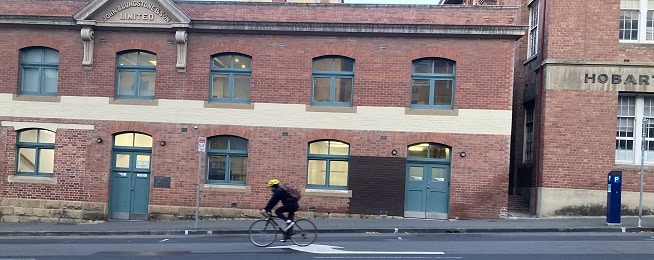The City of Hobart has lodged a development application for separated cycleways on Campbell Street, which were first considered by the council in December 2019.
Representations to the development application have now closed. The application can be assessed by inhouse planners or they may refer it to the Hobart Council planning committee, which next meets on 31 May and then 14 June.
If the development application is approved, the City will put the construction of the cycleway out to tender and then confirm a starting date.
The Campbell Street cycleway is planned between Brisbane and Davey streets and includes two connecting separated cycleways on Liverpool and Bathurst streets, between Campbell and Argyle streets.
However, the Liverpool Street connector will be delayed by construction work at the Royal Hobart Hospital, which will take up road space allocated for the lane.
A few short sections of lane separation will also be built on Argyle Street, but this road won’t receive the same sort of All Ages and Abilities infrastructure planned for Campbell Street as entrances to the multi-storey car park and private and public hospitals make separation difficult.
The new cycleways will made possible by turning on-street parking into clearways during peak-hour. Bollards and painted buffers will provide a physical separation between parked cars or moving traffic and the cycleway.
The cycleways are the first step in a plan to encourage less confident riders to move through the city. They have been designed to an All Ages and Abilities standard, rather than the painted lanes typically used elsewhere on Hobart’s roads.
Bicycle Network strongly supports the City of Hobart’s moves to introduce the first on-road cycleway in the city but there are a few elements of the plan that could be improved.
The project is being proposed as a trial and may include future opportunities for refinement when the trial assessment comes up.

Potential improvements
The cycleway runs past the Collins Street intersection where buses frequently turn right across Campbell Street. This poses a problem, as buses often have to turn from the lane next to the right-hand lane, putting people riding in the drivers’ blind spot.
Moving the cycleway up from the road next to the footpath would reduce conflict at the intersection and create a dedicated crossing point at the pedestrian lights for bikes. This would place riders in a better position for bus drivers and other drivers to see them.
The Bathurst Street cycleway connector is planned on the northern side of the street, however, most bike riders will turn right into Campbell Street or across Campbell Street and travel straight up onto the Rose Garden Bridge.
A cycleway connector on the southern side of Bathurst Street may be more intuitive and useful for most riders.
A bicycle crossing at the pedestrian lights that connects into a lane on the southern side of Bathurst Street would mean people riding up Argyle Street would not have to cross two intersections, and potentially two changes of lights, to access the Rose Garden Bridge or Campbell Street lanes.
Keep an eye on the Bicycle Network Tasmania Facebook page and the next In the Loop for updates.


